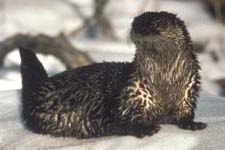Local Wildlife
Northern River Otter

Scientific Name: Lontra canadensis
More Info: Univ. of Michigan
The northern river otter is a semi-aquatic mammal with a long, streamlined body, thick tapered tail, and short legs. They have wide, rounded heads, small ears, and nostrils that can be closed underwater. They are dark brown above and lighter in color underneath. Their fur is dense and soft and their feet are webbed.
These delightful creatures live in a variety of marine habitats including rivers, lakes, marshes, swamps, and estuaries. River otters can tolerate a variety of environments including high elevations, but will not live in polluted waters. The best place to spot one of these otters is in the small stream called Sun River near and to the south of where it empties into Lake Aspen. However, they can also be found in the waterways connecting Lake Aspen to the Deschutes River.
River otters build dens in the burrows of other mammals, in natural hollows, such as under a log, or in river banks. Dens have underwater entrances and a tunnel leading to a nest chamber lined with leaves, grass, moss, bark, and hair. Breeding occurs in late winter or early spring and births occur from November to May. Litters can range from from 1 to 6 young. Born with fur, they open their eyes at one month and begin to leave their mother at six months old. Northern river otters generally live 8 to 9 years in the wild.
Solitary (except for females with their young), river otters are known as playful animals. They get their boundless energy from their very high metabolism, which also requires them to eat a great deal during the day. They are excellent swimmers and divers and are also surprisingly quick on land. These otters have large home ranges and are constantly on the move within their range. They can be seen at all times of day, but usually hunt at night.
